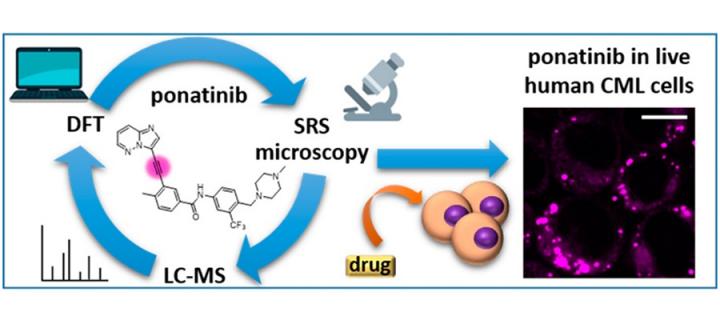Studying intracellular drug distribution using stimulated Raman scattering microscopy
Scientists from the Cancer Research UK Edinburgh Centre applied stimulated Raman scattering microscopy to image an anticancer drug with high sensitivity and specificity in live cells at biologically relevant concentrations: January 2020

The high attrition rates of candidate drugs during clinical development remains a common feature, slowing down introduction of novel therapeutics to the clinic, and increasing drug development costs. Therefore, innovative approaches to drug screening are needed. Incorporating imaging into complex drug screening models has the potential to improve the robustness of preclinical studies of drug uptake, retention and metabolism. The insight gained from such studies could enable earlier removal of ill-fated compounds from the development cycle, with consequential savings in financial investment, and improve the quality of the drug development pipeline. Unfortunately, high resolution imaging of label-free drug distribution in cells and tissues still poses a significant technical challenge. One technology that seems particularly well suited for this type of imaging study is stimulated Raman scattering (SRS) microscopy and our scientists are among the world leaders in developing it for biomedical applications.
In recent work titled “Utilizing stimulated Raman scattering microscopy to study intracellular distribution of label-free ponatinib in live cells”, researchers from the CRUK Edinburgh Centre and the School of Chemistry at the Edinburgh University and the Institute of Cancer Sciences in Glasgow, applied SRS to directly image the anticancer drug ponatinib without the addition of labels, with high sensitivity and specificity in live human chronic myeloid leukemia (CML) cell lines. This was achieved at biologically relevant, nanomolar concentrations, allowing determination of ponatinib uptake and sequestration into lysosomes during the development of acquired drug resistance and an improved understanding of target engagement. The study, led by Professor Valerie Brunton and Professor Alison Hulme, extends the potential of SRS to provide read-outs of drug kinetics, mechanisms of action and mechanisms of drug resistance. It was published in “Journal of Medicinal Chemistry” – a top rated medicinal chemistry journal published by the American Chemical Society.
Stimulated Raman scattering imaging could be transformative to drug discovery processes by providing important information on drug localization, mechanisms of action and target engagement. Our work demonstrates the benefits of this technology in providing real-time measurements of drug distribution in live cells with high sensitivity and resolution.

